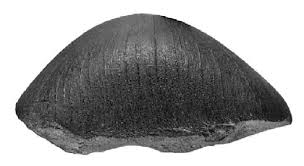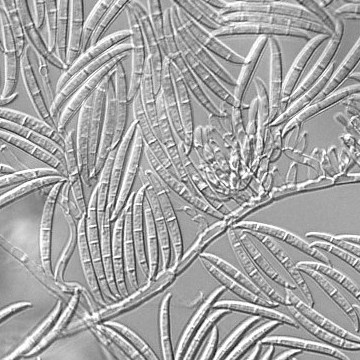A toxin that causes vomiting in pigs helped scientists solve the age-old mystery of the origin of Martian
How did it all start?
In 1931, an unusual stone that was keptin the geological collection of Purdue University in the US, has been identified as an example of a “pristine” meteorite – a piece of space rock ejected from the surface of Mars millions of years ago before being sucked into Earth’s atmosphere. However, how and when the meteorite that became known as Lafayette ended up in the university's collection remained unclear for more than 90 years.
What are the versions?
Scientists have one theory of origin.It is based on the “testimony” of American space rock collector Harvey Nininger, dating back to 1935. According to his story, an African-American student at Purdue University witnessed a meteorite land in a pond where he was fishing. He pulled it out of the mud where it had fallen and donated it to the university.
 Meteorite Lafayette. Photo: NASA
Meteorite Lafayette. Photo: NASA
Previous attempts to confirm this storywere not successful. But researchers have now used advanced analysis techniques and archival data to gather enough evidence to prove the story's veracity. They wanted to understand exactly when it happened—either in 1919 or 1927—and who exactly found the Lafayette meteorite.
Detective investigation
The “scientific investigation” began in 2019,when planetary scientist and PhD candidate Aine O'Brien from the University of Glasgow crushed a tiny sample of the Lafayette meteorite and used sophisticated mass spectrometry to analyze its composition. She tried to find traces of organic molecules preserved in it to learn more about possible life on Mars.
 Dr Ain O'Brien from the School of Geographical and Geosciences at the University of Glasgow in the laboratory of the Scottish Universities Environmental Research Center (SUERC).
Dr Ain O'Brien from the School of Geographical and Geosciences at the University of Glasgow in the laboratory of the Scottish Universities Environmental Research Center (SUERC).
Credit: University of Glasgow/Chris James
Among the thousands of metabolites discoveredAs a result of the analysis, O’Brien noticed a metabolite that was too connected to the Earth - deoxynivalenol (abbr. DON). DON is vomitoxin, literally “vomit toxin.” It is found in Fusarium graminearum, a fungus that infects grain crops such as corn, wheat and oats. In Russia it is called fusarium cereal. If ingested, it causes illness in humans and animals, with pigs particularly affected.
 Fusarium graminearum
Fusarium graminearum
Authorship: fk. Own work, CC BY-SA 3.0
Intrigued by the presence of "vomit toxin"in a Martian meteorite, the planetary scientist told colleagues about it, including those at Purdue University, who were familiar with the story of Lafayette’s “landing” in the mud. They suggested that dust from crops on nearby farmland may have carried DON into nearby waterways and that the meteorite was "contaminated" with the toxin when it fell into the pond.
What did the scientists find out?
Archival records showed that the toxin causeda 10–15% drop in yields in 1919 and another, less pronounced one in 1927. This was the highest prevalence of vomitoxin in the 20 years before 1931, when the meteorite was identified.
Analysis of observations of “fireballs” during the same periodperiod provided more potential clues about the exact time of Lafayette's landing. Meteorites heat up as they descend through Earth's atmosphere, causing a bright streak of fire across the sky. Various documents have reported similar sightings in southern Michigan and northern Indiana on November 26, 1919, and another in 1927, when the Tilden meteorite fell in Illinois.
Who found the meteorite?
Purdue University archivists looked through yearbooks for 1919 and 1927 to find African-American students enrolled at the time.
 Researchers identified four blackstudents from Purdue University, one of whom may have found Lafayette. Clockwise from top left: Hermanze Edwin Fauntleroy, Clinton Edward Shaw, Julius Lee Morgan and Clyde Silence.
Researchers identified four blackstudents from Purdue University, one of whom may have found Lafayette. Clockwise from top left: Hermanze Edwin Fauntleroy, Clinton Edward Shaw, Julius Lee Morgan and Clyde Silence.
Photos courtesy of Purdue University
Julius Lee Morgan and Clinton Edward ShawClass of 1921, and Hermanze Edwin Fauntleroy, Class of 1922, were enrolled at Purdue in 1919. The fourth man, Clyde Silence, attended Purdue in 1927. Scientists have concluded that it is possible that one of these men found Lafayette, according to an origin story shared by Nininger from 1935.
Why is it important?
Co-author of the article, PhD Marissa Tremblay,noted that "the Lafayette meteorite is very important to Purdue, especially now that the university has a thriving planetary science research group that just celebrated its 10th anniversary."
Among other things, he is surprisingly good.preserved. This means that he quickly “recovered” after landing, according to the “official” history of Lafayette’s origin. “I am proud that a century after landing on Earth, we can finally reconstruct the circumstances of his “arrival”,” concludes the author of the study.
The team's paper, "Using Organic Pollutants to Limit the Terrestrial Travel of the Martian Lafayette Meteorite," was published in the journal Astrobiology.
Read more:
Archaeologists have officially confirmed the legends from the Bible
It turned out what happens to the cells of the body when the heart dies
Starlink signal hacked to be used as an alternative to GPS